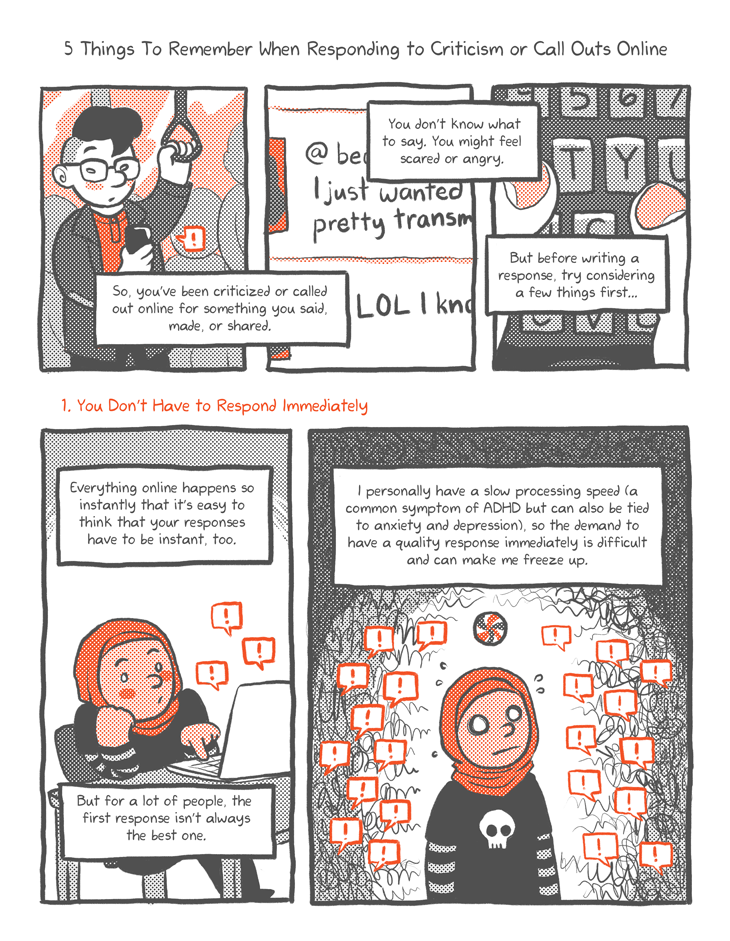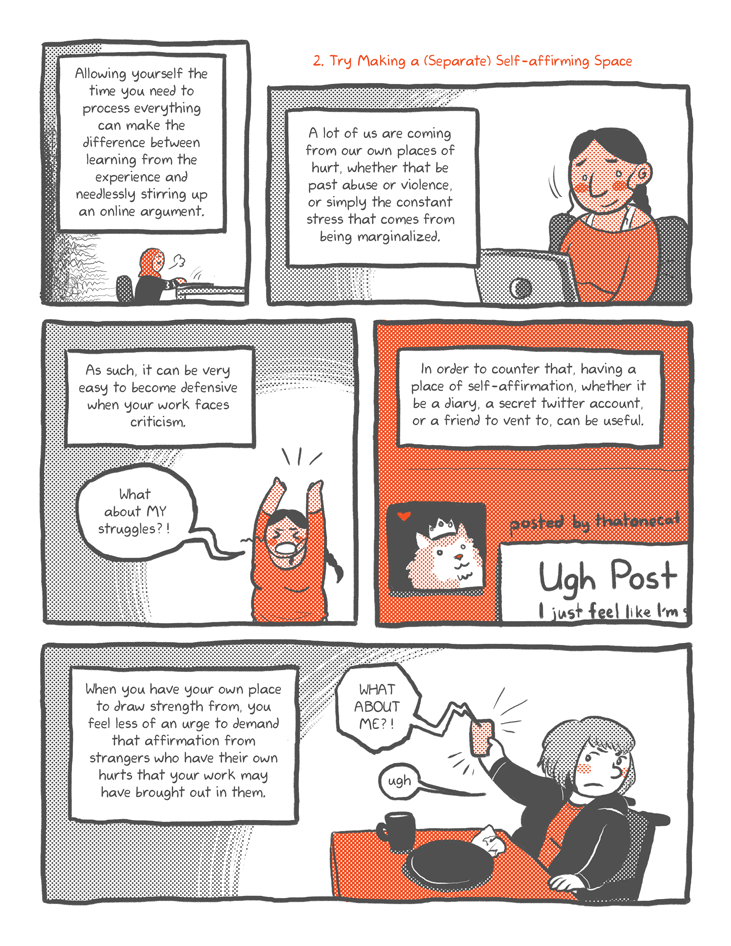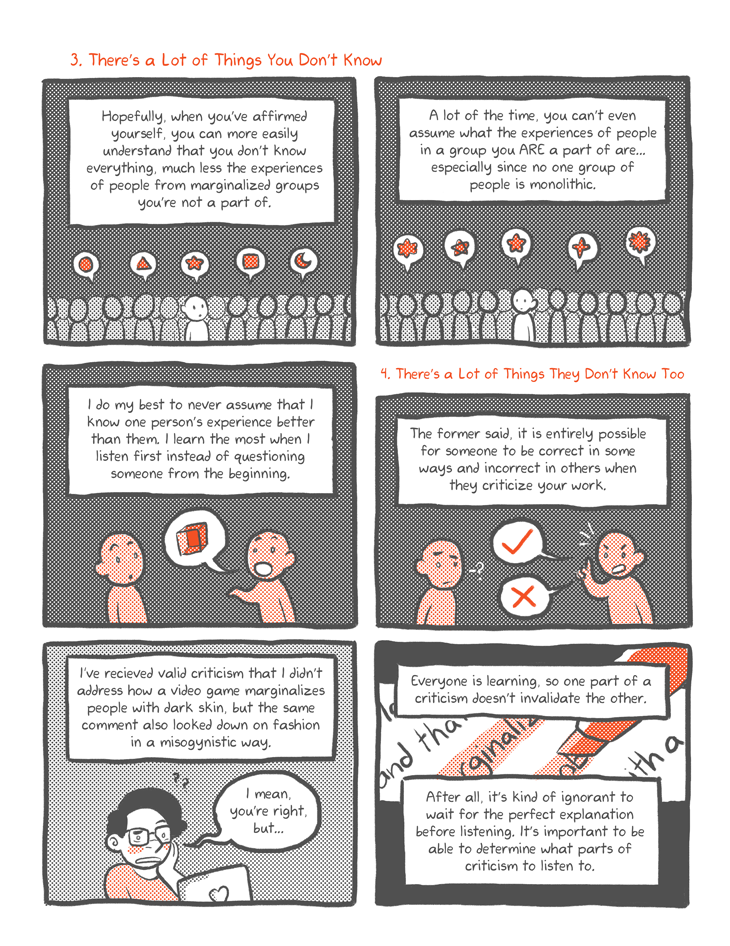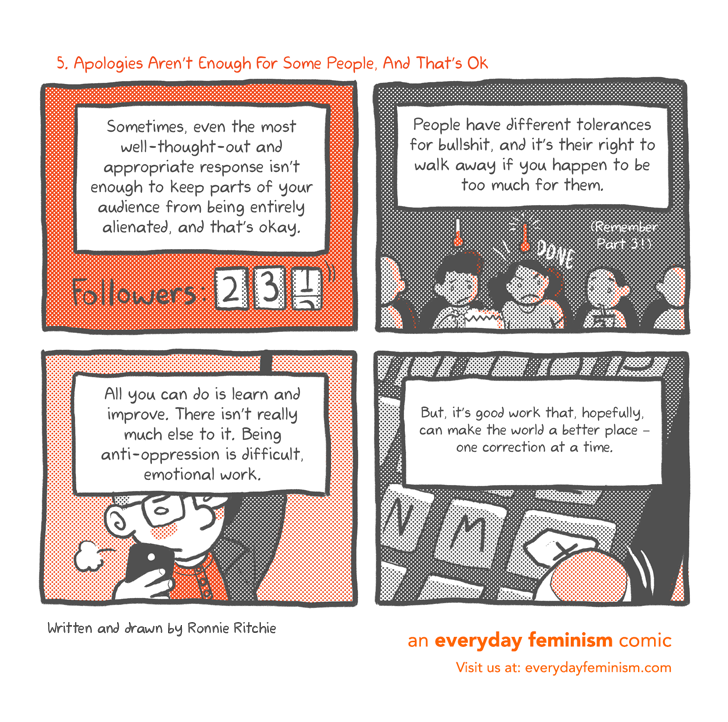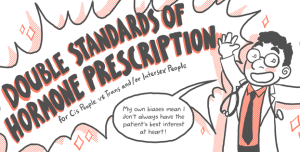Panel 1
(A person with an undercut and a leather jacket is looking at their phone while on a train when a notification pops up on their screen.)
Text: So, you’ve been criticized or called out online for something you said, made, or shared.
Panel 2
(The comment in question appears, only partly visible.)
Comment: I just wanted…. pretty transmisogynistic….
Text: You don’t know what to say. You might feel scared or angry.
Panel 3
(The person’s thumbs hover over the phone keyboard.)
Text: But before writing a response, try considering a few things first…
Panel 4
Text: 1. You Don’t Have to Respond Immediately
(A person in a hijab and a striped shirt is sitting at a table, multiple notifications popping up on their computer, one after the other.)
Text: Everything online happens so instantly that it’s easy to think that your responses have to be instant, too. But for a lot of people, the first response isn’t always the best one.
Panel 5
(The same person stands frozen, surrounded by so many notifications that it creates a cloud of noise behind them. The “please wait” symbol for Mac computers floats over their head.)
Text: I personally have a slow processing speed (a common symptom of ADHD but can also be tied to anxiety and depression), so the demand to have a quality response immediately is difficult and can make me freeze up.
Panel 6
(The flood of noise fades, and the person looks more calm, sighing in relief.)
Text: Allowing your self the time you need to process everything can make the difference between learning from the experience and needlessly stirring up an online argument.
Panel 7
Text: 2. Try Making a (Separate) Self-affirming Space
(A person with a long braid looks to the reader from where they sit with a computer on their lap, nodding an affirmative.)
Text: A lot of us are coming from our own places of hurt, whether that be past abuse or violence, or simply the constant stress that comes from being marginalized.
Panel 8
Text: As such, it can be very easy to become defensive when your work faces criticism.
(The same person yells, waving their arms.)
Person: What about MY struggles?!
Panel 9
Text: In order to counter that, having a place of self-affirmation, whether it be a diary, a secret twitter account, or a friend to vent to, can be useful.
(Image of a post from a person’s personal blog.)
Text: Ugh Post: I just feel like I’m…
Panel 10
Text: When you have your own place to draw strength from, you feel less of an urge to demand that affirmation from strangers who have their own hurts that your work may have brought out in them.
(Another person sits in their wheelchair at a cafe table, holding their phone away from them in distaste. The first person’s voice spills out from Person 2’s phone.)
Person 1: WHAT ABOUT ME?!
Person 2: ugh.
Panel 11
Text: 3. There’s a Lot of Things You Don’t Know
(One person stands in a crowd full of people, all speaking with different shapes filling the speech bubbles, like triangles, circles, and squares. A star fills the central person’s speech bubble.)
Text: Hopefully, when you’ve affirmed yourself, you can more easily understand that you don’t know everything, much less the experiences of people from marginalized groups you’re not a part of.
Panel 12
(The same person is in a different crowd, now all with stars filling their speech bubbles, but none of the stars look exactly like the central person’s star.)
Text: A lot of the time, you can’t even assume what the experiences of people in a group you ARE a part of are… especially since no one group of people is monolithic.
Panel 13
(The person is only with one other person now, listening intently as their companion speaks. A more complex cube fills their speech bubble.)
Text: I do my best to never assume that I know one person’s experience better than them. I learn the most when I listen first instead of questioning someone from the beginning.
Panel 14
Text: 4. There’s a Lot of Things They Don’t Know Too
(The same two people are together, person 2 still speaking, but one speech bubble has a positive check while the other has a negative X. Person 1 looks on, confused and concerned.)
Text: The former said, it is entirely possible for someone to be correct in some ways and incorrect in others when they criticize your work.
Panel 15
Text: I’ve received valid criticism that I didn’t address how a video game marginalizes people with dark skin, but the same comment also looked down on fashion in a misogynistic way.
(Ronnie sits in front of their laptop, their face in one hand, confused.)
Ronnie: I mean, you’re right, but…
Panel 16
(Several lines of text sit on a page. A highlighter is running over one of the lines of text, highlighting it.)
Text: Everyone is learning, so one part of a criticism doesn’t invalidate the other. After all, it’s kind of ignorant to wait for the perfect explanation before listening. It’s important to be able to determine what parts of criticism to listen to.
Panel 17
Text: 5. Apologies Aren’t Enough For Some People, And That’s Ok
(A graphic shows a follower count for a social media account. It was 232, but the last 2 scrolls down and is replaced by a 1 as the account loses a follower.)
Text: Sometimes, even the most well-thought-out and appropriate response isn’t enough to keep parts of your audience from being entirely alienated, and that’s okay.
Panel 18
(Two people sit in a movie theatre, thermometers above their head. For one person, the thermometer is partially full, but for the other, it is entirely full, the state labeled as “DONE”. The done person looks entirely disgusted.)
Text: People have different tolerances for bullshit, and it’s their right to walk away if you happen to be too much for them. (Remember Part 3!)
Panel 19
(The person on the bus from panel 1 sighs, fidgeting with their phone.)
Text: All you can do is learn and improve. There isn’t really much else to it. Being anti-oppression is difficult, emotional work.
Panel 20
(A close-up of the person as they press the backspace key on their keyboard.)
Text: But, it’s good work that, hopefully, can make the world a better place – one correction at a time.
